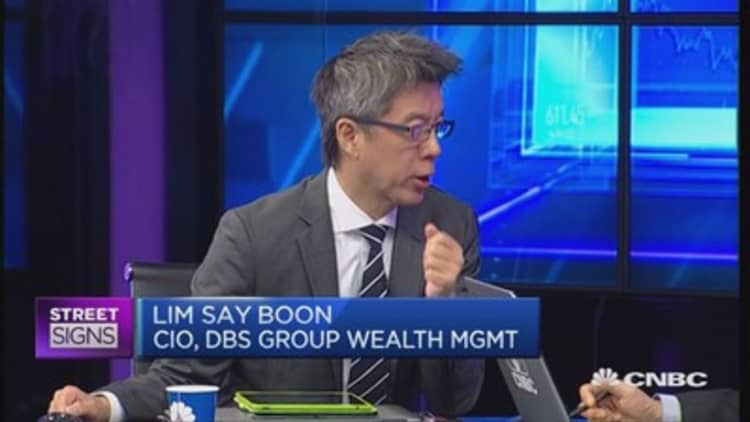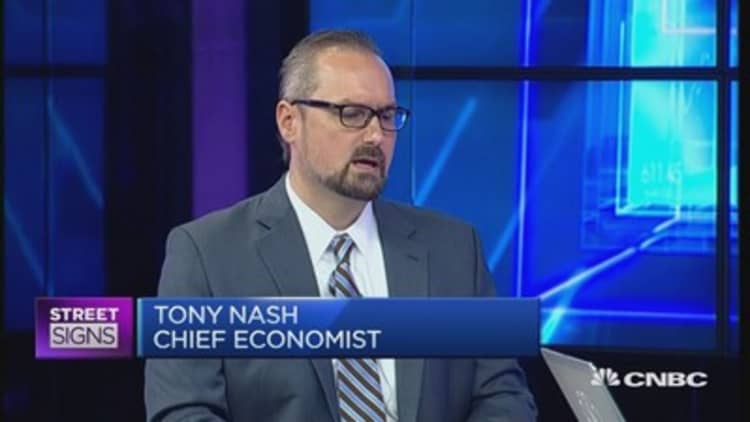


It used to be said that the U.S. sneezed and the world caught a cold. Now, as China's economy looks to be coming down with something nasty, countries in the region are loading up on prophylactic measures.
But just how dependent are Asia Pacific's economies on Chinese growth - and its related appetite for imports - and what are they doing to tide themselves over a slowdown? CNBC looks at how the region's exporters are coping with China's transition.
Japan
China's waning appetite for Japanese products not only helped force Japan's economy into a 1.1 percent contraction in the fourth quarter of 2015, it has also dented confidence in Abenomics, the economic stimulus policies upon which Prime Minister Shinzo Abe has staked his leadership.
Japan's industrial output fell 6.2 percent on-month in February--the most since 2011 when a devastating earthquake and tsunami hit the country--government data showed on Wednesday, reflecting weak factory activity due to slow demand both at home and abroad.
Japan's exports have declined 8.5 percent on average in January and February, compared with a 8 percent drop in December, official data show.
"Weak imports of materials and consumer goods suggest sluggish production and a sustained slump in consumer spending. These remain a concern as a downward risk for real GDP growth over the near term," said IHS Global Insight's principal economist, Harumi Taguchi.
"Many investors are concerned that Abenomics has lost momentum. Despite recent BOJ (Bank of Japan) actions, equity and forex markets have yet to stabilize. Moreover, the other elements of Abenomics, fiscal and growth policies, seem to have vanished from the policy debate," wrote Morgan Stanley Japan's managing director Robert Alan Feldman in a note in early March.
As a result, the BOJ introduced negative interest rates in January for the first time, stunning markets and spurring intense debate about the role of central banks in stimulating economies.
Standard Chartered Wealth Management's Manpreet Gill told CNBC on Wednesday that the BOJ's hands are tied as far as the yen is concerned and measures targeting longer-term reforms such as wage growth need to come through.
A senior official at the Organisation for Economic Co-operation and Development (OECD) recently told CNBC that Japan had exhausted all other options for kicks-starting growth and needed to institute structural reforms.
"We see some structural reforms that are very positive (such as)the TPP (Trans-Pacific Partnership) and the efforts on corporate governance, trying to more promote more focus profitability and risk-taking so we see some reforms that are very much in the right direction but they take time to bear fruit," OECD's Jones told CNBC.
On Wednesday, Abe told reporters that the government is targeting to double inbound tourist numbers to 40 million by 2020 and to push that number to 60 million by 2030 to boost the economy.
South Korea
China is South Korea's top trading partner, taking up to 30 percent of the country's exports. With China buying less, South Korean exports have contracted for the past 14 straight months.
The South Korean economy is heavily dependent on exports, which accounts for half of the country's GDP.
To help reverse its faltering exports, South Korean signed a free trade agreement with China that took effect in December. And it has sought new business partners, recently cozying up to Iran with Seoul signing a 5-billion-euro agreement with the Middle Eastern country.
And although industrial exports are on the wane, South Korea is looking to tap China's growing middle class by promoting its consumer goods industry. Beauty and baby products are key segments that could cash in on the popularity of South Korean pop culture in China.
The Associated Press reported in December that the South Korean government is planning to increase its assistance to consumer products companies with the potential of reaching out to the Chinese market.
Tourism is also an important contributor to the South Korean economy, with the number of Chinese tourists to South Korea 5.7 percent higher in February from a year ago, even amid a weaker Chinese economy.
HSBC said in a note recently that the number of Chinese inbound tourists to South Korea would likely grow 25 percent in 2016, as South Korea opens new duty-free shops and offers visa-free access to the resort island of Jeju for Chinese nationals.
Australia and New Zealand
A large exporter of iron ore and coal, Australia has been hurt by the double whammy of a construction slowdown in China as well as a Chinese state-backed environmental clean-up campaign that is expected to spur a switch to cleaner energy sources.
Australian trade minister Steven Ciobo, who was recently in the U.S. to promote the country as an investment destination for U.S. businesses, told CNBC that Australia was turning to the services side of its economy for growth.
"You know services represent 70 to 80 percent of Australia's economy yet it's only about 20 percent of our exports. So there's a lot of scope for us to do more in the services sector," he said.
Many are counting on tourism as the growing Chinese middle class seeks new thrills.
"China up to now has been a volume(-driven market) at the mid to lower end of the budget. They are now moving up that budget chain, so we are seeing many more premium Chinese visitors who are wanting better experiences and they are willing to pay more for it," said Andrew McEvoy, chairman of Sealink,a tour operator.
Tourism aside, Australia's investment in financial technology and tech-supporting infrastructure has achieved some returns.
Recruiter Robert Walters told CNBC that American tech companies were attracted by Australia's highly-skilled IT workers and a weakened currency.
Neighboring New Zealand, meanwhile, is crying over spilt milk since China's dairy demand has stalled. China is a major buyer of NZ dairy products, the country's major export.
Tourism,however, is a standout industry in "the Shire" and would likely to be a key driver of growth going forward, analysts said.
The country, famous for providing the settings for Peter Jackson's Hobbit and Lord of the Rings film series, welcomed 373,400 visitors in February, a 8.7 percent increase on the same month a year ago, government statistics showed. The number of visitors from China rose 28 percent in the 12 months to February 2016.
Southeast Asia
Large commodities exporters Indonesia and Thailand have both been hit by tanking prices for minerals, palm oil and rubber. Those exports make up 60 percent of exports for the former and over 10 percent for the latter.
China is a top buyer for palm oil and rubber, key farm exports for these countries.
Both countries are attempting to absorb some of their abundant supply through building infrastructure such as roads and railways.
There has been some success last year; Indonesia reported 4.9 percent growth in household consumption in the fourth quarter of 2015 and full-year growth of 4.8 percent.
Thailand's economy also looked relatively healthy, recording the fastest quarterly growth in the year over the last quarter of 2015, as the military government's infrastructure stimulus spending and an increase in the number of inbound tourists — of which Chinese were the largest group — offset faltering local demand and exports.
Shipping hub Singapore meanwhile saw its February non-oil domestic exports contract 4.1 percent from a month ago, although they were up 2.1 percent on-year following a 10.1 percent plunge in January.
Government statistics show layoffs in Singapore hit their highest levels since the global financial crisis in 2015, highlighting the adverse impact of sustained low oil prices on the city-state.
Last week, the government announced it will spend $53 billion for the fiscal year starting April 1, a 7.3 percent rise from the previous year with the bulk of funds are directed at supporting businesses, especially (SMEs), with measures including higher corporate income tax rebates.
Hong Kong and Taiwan
With China as its hinterland, Hong Kong has enjoyed enviable economic growth over the past few decades, but that is now slowing in tandem with China, amid increasing social discontent.
Also weighing on Hong Kong's economy is a curtailment in luxury spending by the Chinese visitors due to an ongoing austerity drive and corruption crackdown back home.
Data released late February showed that Hong Kong's gross domestic product grew 2.4 percent in 2015, and is expected to slow to 1 to 2 percent in 2016.
To bolster its economy, Hong Kong is cutting taxes for small and medium-sized enterprises and waiving license fees for hospitality players hurt by the slowdown.
Across the Taiwan Strait, another territory is grappling with China's slowdown; 40 percent of Taiwan's exports go to China. But the amount China is purchasing has plunged, with export orders from China falling 12.1 percent on-year in February, Reuters reported citing official data.
In the hope of diversifying its economy away from a reliance on China, Taiwan is now jostling to join the U.S.-led TPP. It has not yet been included in any such negotiations.
Nyshka Chandran contributed to this article.



